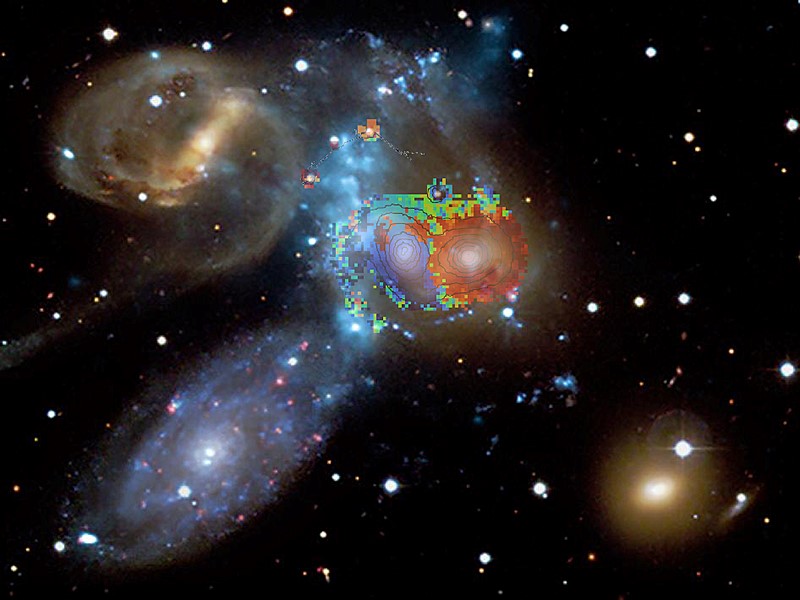Observations almost 100 times faster than before
This is the power that the WEAVE instrument installed on the William Herschel telescope at the Roque de los Muchachos Observatory makes available to astronomers. It has just proved it by capturing its first lights, coming from Stephan’s Quintet, a group of five galaxies, some of which are colliding.

Scientists from the Isaac Newton Group of Telescopes (ING) [1] were particularly interested in the latter, NGC 7318a and NGC 7318b. The spectra reveal the presence of gas well outside the galactic disks : the hydrogen clouds are pushed out of their orbits by the high speed intrusion, almost 3 million km/h, of the galaxy NGC 7318b, which is moving directly towards us through the center of the Stephan Quintet (see images).
These observations were made with one of the three modes of WEAVE, in which 547 closely spaced optical fibers send light from a hexagonal area of the sky to the spectrograph, where it is analyzed and recorded. WEAVE’s first light demonstrates not only that it works, but also that it produces high-quality data promising important discoveries in the years to come.

What you should know :
|
**French contribution
The construction of WEAVE was funded in France by the CNRS, the Observatoire de Paris-PSL, the Île-de-France [2] and Bourgogne-Franche-Comté.
WEAVE also benefited from the expertise of the laboratories Galaxies, étoiles, physique, instrumentation (Observatoire de Paris - PSL / CNRS) and Lagrange (CNRS/Observatoire de la Côte d’Azur/Université Côte d’Azur), with the support of the Observatoire des sciences de l’Univers Terre homme environnement temps astronomie (CNRS/Université Bourgogne Franche-Comté) and the Institut Univers, temps-fréquence, interfaces, nanostructures, atmosphère et environnement, molécules (CNRS/Université Bourgogne Franche-Comté).
These French laboratories will participate with others [3] in the future programs of observations.
_________________________________________________________________________________
[1] The ING consists of two telescopes located at the Roque de los Muchachos Observatory. In 2016, the ING partnership countries (the United Kingdom, Spain, and the Netherlands), joined by France and Italy, signed an agreement to design and build WEAVE, with each country contributing major components, and ING providing ancillary systems and overall project management
[2] The WEAVE project was funded under the Domaine d’intérêt majeur "Astrophysics and conditions for the appearance of life" 2012-2016 of the Île-de-France region.
[3] The Laboratory of Astrophysics of Marseille (CNRS/Aix-Marseille University/CNES), the Laboratory of Astrophysics of Bordeaux (CNRS/University of Bordeaux), the Institute of Planetology and Astrophysics of Grenoble (CNRS/University of Grenoble Alpes) and the Astronomical Observatory of Strasbourg (CNRS/University of Strasbourg)
